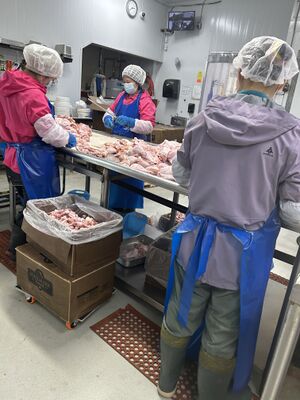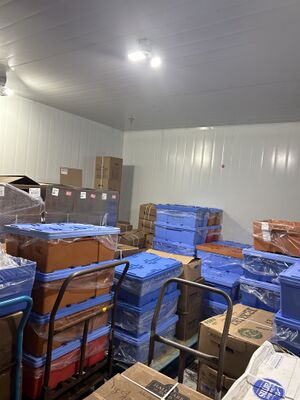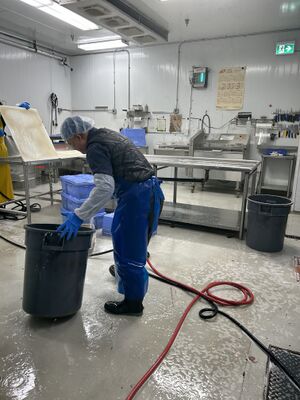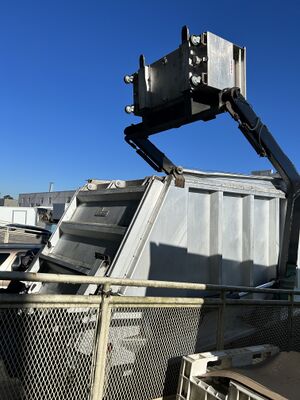Course:FNH200/Projects/2023/Interview with Edith from ABC Meat & Poultry
Introduction

ABC Meat & Poultry was not Edith’s first foray into the meatpacking business. At her last company, a friend and coworker had a desire to start his own venture. He knew all the right people in food service to sell to but needed a partner to run the business side of things. 14 years later, Edith continues to co-operates ABC in Richmond, BC, with fast food chains, restaurants, and golf clubs among her usual clients. When asked about her favourite part of her job, Edith warmly responds that she enjoys “[forming] friendships with her customers.”
At ABC, Edith and her team receive slaughtered and cleaned chickens and sections of pork and beef to further break down into ready-to-cook cuts. Restaurant clients will specify the cut and preparation of the meat with a specific dish in mind. For fresh meats, this includes chicken thighs and drumsticks. For frozen meats like beef, specialized machinery achieves a number of shapes from cubes to paper-thin slices. The introduction of additional meat processing machines reflects industry-wide labour shortages for both meatpacking and restaurants. Fewer employees are required to work in ABC’s facility and fewer hours in the restaurant are dedicated to handling meat.
State of Meat Processing
In 2015, BC’s meat manufacturing industry generated $1.6b. worth of product, representing 4% of the province’s manufacturing activity. According to labour statistics, there were 54,137 meat processing employees in 2012 working in BC.[1] However, job vacancy rates across the animal production industry have been increasing as early as 2018[2], prior to the coronavirus pandemic. The Temporary Foreign Worker program restricts the proportion of low-wage workers on job sites to 30% in 2023 (up from 20%)[3], affecting the availability of workers in industries like meat processing and agriculture.
Consumer Trends & Production Statistics

According to module 1.6, Canada’s food consumption is constantly changing according to consumer preferences and perceptions. Edith shared that chicken breasts are their most popular product. This would be in line with consumer preferences, as poultry availability increased by 1.5% to 25.5 kg (boneless weight) per person in 2022.[4] Alternative sources suggest that consumption of meat by Canadian consumers was $601.1 in 2021, and these numbers are expected to increase to 723.1 by 2026.[5] It seems that ABC Meats is in a market that will continue to thrive.
Despite the rapid increase in chicken consumption, Edith did mention that some restaurants are changing menu items to cater to non-meat eaters. Still, this trend seems to be uncertain, as there is mixed evidence of plant-based food trends. One source suggests that people are beginning to challenge plant-based food options due to negative health implications. In fact, 35% have reduced these purchases. On the other hand, the plant-based market is still cited to be a big opportunity, as 29% of consumers are trying to limit their meat consumption.[6]
To meet consumer demand, ABC primarily sources their meat from across the country. The beef mainly comes from Alberta, but occasionally Edith sources it from Australia. This reflects the information from module 1.4, which suggests that meat in short supply can be imported from other countries. All of ABC’s beef comes frozen, but all of the chicken and some of the pork are fresh. Pork can be locally sourced, but due to slim restaurant margins, much of the product comes from Maple Leaf Farms in Ontario. This suggests a balance of finding the highest quality of meat that can be sold at a profitable margin. Depending on the cut of pork, it can be frozen or fresh. Edith mentioned that pork shoulder is usually fresh. Further, for most efficient slicing, the meat must be frozen, and for grounding, the meat must be fresh.
For poultry, all of the chicken is locally sourced. Because of this, she is able to always only sell fresh chicken, and this product is never frozen. Also, Edith and ABC Meats have good working relationships with local suppliers who are happy to provide poultry at a price both suppliers and customers can agree on. This is likely possible because chicken production is B.C.’s third-largest land-based agricultural industry, equating to 11% of the provinces agricultural income.[7] Furthermore, the BC Farm Industry Review Board also states that chicken is the most consumed animal, resulting in constant increases in Canadian production. The chicken that ABC Meats receives comes in parts, and they debone it themselves.
Supply Chain Shortages
When we consider the seasonality of food, produce is often what comes to mind as discussed in module 1.4. Nonetheless, factors such as weather and illness can affect the supply and price of livestock. Like people, chickens are subject to heat stress and overheating.[8] During seasons of avian flu, poultry stocks also decrease, raising prices.[9] For the most part, Edith claims that the supply of chicken is relatively steady.
During December, the melting pot of holidays leads to both increased demand for meat products and a shortage of willing employees as they leave for vacation. According to Edith, at companies in two major meat-producing provinces, Ontario and Calgary, employees are only working half the month. Planning ahead, ABC orders meat ahead of time to build its frozen reserves.
Effect of the COVID-19 Pandemic
Some of the questions for Edith regarded adaptations to the pandemic. The shutdown of restaurants and gathering places meant suppliers had to pivot quickly. She explained her strategy, which involved focusing on home delivery. Word-of-mouth advertising on social media allowed ABC to sell smaller portions at a time to the local communities. This flexible approach to overcoming big market shifts further illustrates information from module 1.6 suggesting the many ways that food consumption patterns have shifted and continue to shift and showing how businesses must adapt to changing consumer demands and external influences.
That said, according to Retail Insider, in the first quarter of 2023, the restaurant industry made a booming recovery, with their visits increasing by 11%, with spending increases of 18% by the end of the quarter in March compared to the prior year.[10] Further, Statistics Canada has suggested that total food sales have already bounced back to their pre-pandemic levels.[11] This is auspicious news for Edith, her team, and other food suppliers across Canada.
Refrigeration and Freezing

ABC’s 40 ft freezers are all set at a temperature of -21°C for pork and beef products. Typically, storage temperatures of -18°C allow the meat to last in the range of 10-14 months, depending on the cut of meat. This also happens to be the minimal temperature for commercial freezing. Table 7.1 in module 7.3 suggests 10 months for pork at this temperature and 13-14 months for raw beef. Nonetheless, at ABC, the inventory of frozen meat turns over within just 2-4 weeks. Despite its safety, at the 1-year mark, the frozen meat takes on undesirable changes in smell, taste, colour, and texture to an extent that is no longer suitable for sale. In module 3.2 we learned that our sensory evaluation of foods plays a very important role in shelf life studies and how we manage quality control. So, adverse changes in the smell and looks of the products would likely also have a negative impact on sales.
Optimal fridge temperatures for refrigeration according to Health Canada[12] are set at 4°C or lower because bacteria can grow rapidly above 4°C. At ABC, they notice that meat that is stored in the fridges for more than a week will produce drip loss. However, Edith mentioned that they only keep meat in the fridge for 1 to 2 days before it is sold.
For retail consumers, careful attention is paid to the packaging and appearance of refrigerated and frozen meat. Because ABC sells primarily to restaurants, meats change hands fewer times and thus suffer less temperature fluctuation. As mentioned in module 7.3, the key consideration for packaging frozen foods is to prevent the transfer of moisture from the storage environment to the food. For both frozen and fresh products, thick clear plastic bags are used. Boxes received from meatpackers and slaughterhouses are reused during storage in freezers and fridges until they are passed on to restaurants.
One inquiry for Edith was related to challenges that she has had to overcome. The only other obstacle than COVID that she mentioned was in regards to electricity. Throughout Edith’s 14 years in the company, she says she has experienced on average a power outage once a year. On one occasion, Edith mentioned that the freezer did drop to a temperature of -10°C after a power outage, but she also said that modern freezers are quite good at maintaining temperatures if the doors remain unopened. So, although this has been a challenge, these issues have not been too impactful.
Sanitation

Sanitation is incredibly important in the meat distribution facility. Module 12.0 mentions the fact that food borne disease impacts a large portion of the Canadian population through microbiological, parasitic, animal, and chemical processes. Three diseases that are of particular concern for meat handlers, along with preventative measures are further discussed in module 12.8.1. These diseases are Salmonella spp., Escherichia coli O157:H7 (Shiga toxin), and Listeria monocytogenes. Public Health Canada [13] discusses these in detail; Listeria is the leading cause of deaths related to food-borne illnesses each year, with an average of 35 deaths, and 178 illnesses. Salmonella is widespread, leading to 88,000 yearly illnesses, yet fewer deaths (about 17 per year) are related to this disease. E. Coli O157 represents another large number of illnesses related to food-borne bacteria, with approximately 12,800 illnesses and 8 deaths per year. All this suggests the tremendous importance of sanitation within the facility. Inspection Canada speaks of environmental contamination, and certain necessary procedures. [14] For instance, the operators need to have established guidelines for managing potential contamination from the environment, such as handling meat that drops on the floor, dealing with condensation risks, and ensuring sanitary equipment storage measures. Module 12.8.3 further illustrates the importance of sanitary measures with an experiment related to the rapid compounded growth of bacteria in a non-sanitized compared to a sanitized environment (in this case, an agar plate of a “soiled hand” that had handled raw pork, versus a “washed hand”). Module 12.8.2 outlines a major problem; food is often handled in large quantities. So, if proper handling and sanitary procedures are not taken, contamination can and does occur. British Columbia Ministry of Health also conducts routine health inspections of food service establishments, and is involved with the provincial inspection of meat processing plants (table 4.1).
Waste

After preparing various cuts, Edith and her team make sure no carcasses or fat go to waste. Some of their clients will request the leftover bones to make soup stocks. Most of the bones are collected once a week by a company and sent off to Calgary for processing. The bones are then turned into consumer goods such as pet food and cosmetics. Edith’s daughter, having recently completed culinary school warns her mother against French-style cuts, as less desirable portions of edible meat are often discarded, creating more waste and less product. What is left over is collected to create compost.
Conclusion
With the rising cost of food in mind, we were curious if shrinking restaurant budgets would shift the type of products sold by ABC. Edith was adamant about maintaining the quality of her product, even if that meant keeping prices at a premium. Inevitably, certain customers could no longer afford fresh chicken and pork, turning to frozen alternatives instead.
Before we ended our interview with Edith, there was one question we were dying to know. As someone with access to an abundance of suppliers and restaurants in the food capital of Western Canada, what was her favourite cut? With certainty, Edith chose “a rack of lamb.” Going against both supermarket staples and unusual new school cuts, the rack of lamb feels traditional and luxurious, a cut that would be served at a restaurant with a dress code and mahogany-clad walls. This is, of course, in stark contrast with Edith’s witty and easygoing personality.
Notes
Due to sanitary reasons, it was not possible for us to visit the site, so we were unable to provide a 5-minute video showing points of interest. Thankfully, Edith was able to provide photos of the 5 points of interest which we have discussed throughout the work. The 5 points of interest that were discussed are the refrigerator/freezer units, the waste disposal area, the meat slicer, the deboning table, and the sanitation area.
A pseudonym was also created for the meat distributor, to protect the privacy of Edith and her company.
Further Inquiries
Question 1:
Seasonality of Chickens: Edith mentions about chickens getting sick when it’s hot out. When does this occur and why does it occur?
Chickens usually fall sick when their temperature falls above the optimal temperature. They have an optimal temperature between the range of 65°-75°F. If a chicken’s temperature is greater than 75F, it can damage their organs and potentially reduce their life expectancy.[15] Since chickens do not have sweat glands, heat is therefore trapped under their feathers. Not only this, but heat stress can occur among chickens. Heat stress occurs when air and humidity temperatures uncontrollably elevate their core body temperatures to lethal temperatures. Signs of heat stress include panting, where the body attempts to lose heat through evaporative cooling.[16] Panting will result in increasing their water intake and if no changes have occurred to lower their core body temperatures, the birds may die.
Question 2:
Edith mentions that the beef they receive is always frozen. Why?
According to the Sustainable Agriculture Research and Education (SARE) organization, they determined that "there is no difference in quality" (SARE, 2023)[17] between fresh beef and frozen beef. Furthermore, frozen beef is possibly more tender than fresh beef due to the aging process that occurs in fresh beef during transportation. Frozen beef can still retain all of its nutrients, quality and taste and still be considered as good as fresh beef.[18] In addition, frozen beef has a more extended shelf life as compared to fresh beef.
Question 3:
Why do refrigerated meats have to be sold within 1-2 days?
Typically raw poultry is kept in fridges for 1-2 days while fresh pork (and uncooked beef) can be stored in fridges for up to 3-5 days, then it should be used for cooking or freezing.[19] Fresh meat is high in water content, which favors the growth of microorganisms and usually the meat already contains bacteria that can cause diseases.[20] Also, because refrigerating meat can only slow down bacterial growth but not prevent it, it is best to have the meat sold to the consumers within 1-2 days.
Exam Question
Which of the following statements best captures the overall state and trends of the meat processing industry in BC?
A) The consumption of meat in Canada has steadily declined, with restaurants catering more to non-meat eaters.
B) Despite the increasing popularity of chicken, the meat processing industry in BC is suffering due to the lack of employees and stringent import restrictions.
C) The meat processing industry in BC has faced challenges from the COVID-19 pandemic, but has shown resilience by adapting to changing consumer preferences and external challenges.
D) Chicken consumption in Canada has been declining over the years, with plant-based alternatives taking the majority share.
Correct Answer:
C) The meat processing industry in BC has faced challenges from the COVID-19 pandemic, but has shown resilience by adapting to changing consumer preferences and external challenges.
Explanation:
This question should be on the final exam because it covers a major challenge that the meat processing industry in BC faced, requiring students to understand different elements such as consumer preferences, and the impact of COVID-19. Furthermore, it prompts students to reflect on how businesses adapt to changing circumstances, showcasing the real-world implications of the knowledge they've gained throughout the course.
References
- ↑ "BC Meat Processing Sector 'Cut to the bone': Labour Market Partnership Engagement". BC Association of Abattoirs Sector Labour Market Partnerships. December 2016. Retrieved 10 August 2023.
- ↑ "An analysis of recent issues faced by the Canadian pork industry". Government of Canada. 31 August 2020. Retrieved 10 August 2023.
- ↑ "Program requirements for low-wage positions". Government of Canada. 19 June 2023. Retrieved 10 August 2023.
- ↑ "Food availability, 2022". Government of Canada. 31 May 2023. Retrieved 10 August 2023.
- ↑ "Customized Report Service – Canadian pork meat trends". Government of Canada. 25 May 2022. Retrieved 10 August 2023.
- ↑ Sloan, A. Elizabeth (1 April 2023). "The Top 10 Food Trends of 2023". Institute of Food Technologists. Retrieved 10 August 2023.
- ↑ "B.C. Chicken Industry 2022" (PDF). Government of British Columbia. Retrieved 10 August 2023.
- ↑ Wright, Ashley. "MANAGING BACKYARD CHICKENS DURING PERIODS OF EXTREME SUMMER TEMPERATURE". USDA National Institute of Food and Agriculture. Retrieved 10 August 2023.
- ↑ Aslam, Sonia (5 January 2023). "Don't be surprised by high food prices as picture of raw chicken goes viral". City News 1130. Retrieved 10 August 2023.
- ↑ Charlebois, Sylvain (11 June 2023). "Reports Reveal Canadian Restaurant Industry's Remarkable Revival As Consumers Defy Inflation [Op-Ed]". Retail Insider. Retrieved 10 August 2023.
- ↑ "They're back! Food and drink sales surpass pre-COVID-19 pandemic levels in March, but challenges remain". Government of Canada. 18 July 2022. Retrieved 10 August 2023.
- ↑ "Safe food storage". Government of Canada. 5 July 2021. Retrieved 10 August 2023.
- ↑ "Publications - Food and Nutrition". Government of Canada. July 05 2016. Retrieved August 10 2023. Check date values in:
|access-date=, |date=(help) - ↑ "Food safety for industry - Canadian Food Inspection Agency". Government of Canada. July 12, 2018. Retrieved August 10, 2023.
- ↑ "Ideal temperature and humidity for hatching and raising backyard chickens". SensorPush. 16 February 2023. Retrieved 11 August 2023.
- ↑ "Preventing Heat Stress in Poultry". University of Minnesota Extension. Retrieved 11 August 2023.
- ↑ "Frozen vs. Fresh". SARE. 02 November 2020. Retrieved 11 August 2023. Check date values in:
|date=(help) - ↑ "Fresh vs Frozen Meat: Why it Doesn't Matter". Dolphin Group. 19 October 2022. Retrieved 11 August 2023.
- ↑ "How Long can you Safely Store Meat". Healthline. 06 February 2023. Retrieved 11 August 2023. Check date values in:
|date=(help) - ↑ "Microbes in Raw Meat". AZO Life Sciences. 11 January 2023. Retrieved 11 August 2023.